Study these images (If you click them, they get bigger).
These are our colleagues out on the front lines, witnessing for justice. RIGHT ON, clergy!
Who do you want to follow? This is an urgent question right now.
Who looks like they have integrity, authority, a compelling presence that you, if you were undecided about whose voice to heed, might lend your ear and your trust? I feel stirrings of pride in almost all of these images but I’m a minister! It’s easy for me to cheer for the team. What I find challenging is to regard these images as the average, skeptical American might. What do these people look like to them?
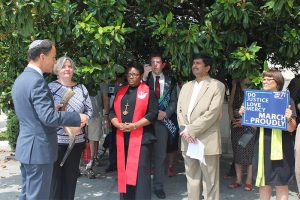
Who isn’t thinking through their attire and their public image? I see a few bloopers.
I also find that, in general, there are too many colors and patterns for my eye to follow, and I think to the average viewer that might look a little cray-cray. I’m not sure, though. Do you think most people seeing these images know what a stole even is? I find that I respond well to a simple suit and collar, or to a white or black robe or outfit under a stole.
Who is assuming a clergy privilege that no longer exists in America, and presuming that they can get away with dressing like a slob and still be taken seriously?
You see it, right? Not good. Really insulting.
Remember that these images are seen by millions more people than will ever hear even one of our well-crafted sermons or even a sentence. Our face, our bearing, our sign, our body language, our gestures in photos or short videos are the only means of communication we have to reach this divided nation. We must be savvy about how we use them.
Blessings on all those who show up.
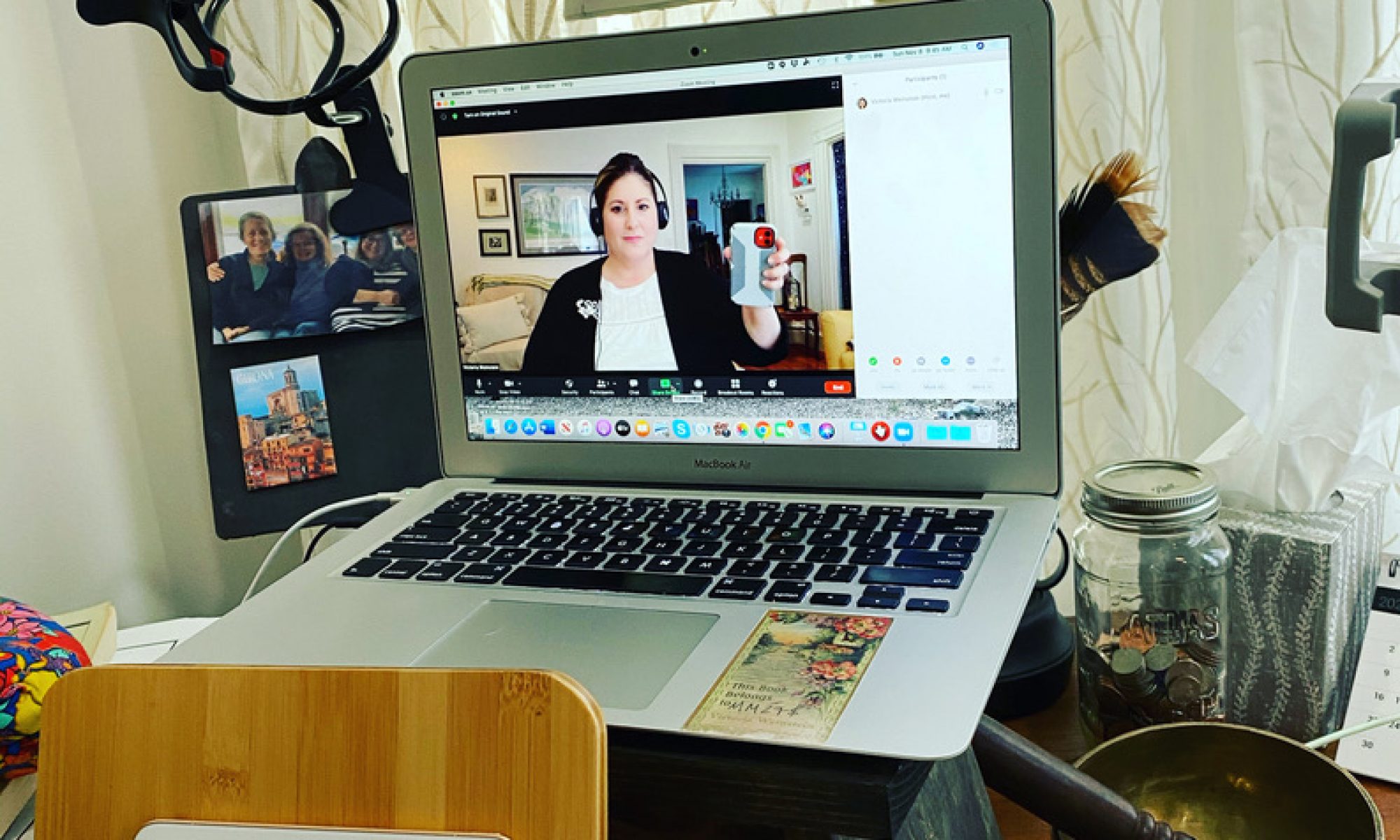
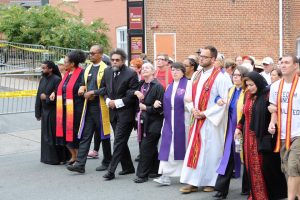
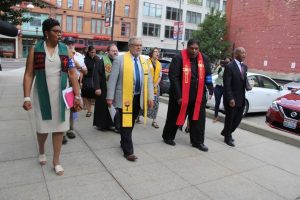
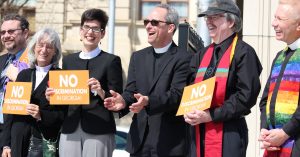
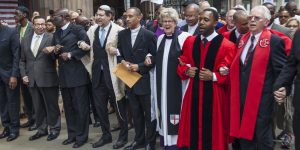
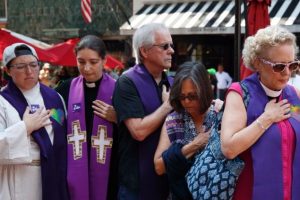
I’ve been really curious about the full robes/stoles that some clergy wore, and wondered if that was an intentional part of the organizing/strategy for the action, and how it was part of the narrative of that day. And I really wondered about the guy at the end, who either missed the memo, or could care less, and showed up in cargo shorts and a T-shirt (and … perhaps there is more to that story!).
What I notice is that it, a stole appears to be a substitute for a clerical collar for those traditions where the norm is to dress in street clothes. They serve a way of marking the wearer as clergy. I wonder if that’s needed. I notice that simple, professional clothing speaks volumes. I don’t understand choices to combine liturgical garments with street garments. Thanks for the images.
The first thing I noticed is that I was put off by the first photo, but not until I saw the second photo. In the first one, a wide swath of clergy are marching with locked arms as though they believed they were going to run into a mass of… what, counter-protesters, police? Anyway, it’s a pugilistic stance.
The second photo, and especially the third one, are much more appealing to me because the people look human and approachable. Walking with locked arms to me says “Stay away,” whereas laughter is always an invitation.
I see some really eccentric accessories now that I look again. I don’t feel like the ones with the wacky accessories project project leadership — but kindly spiritual people who mean well. That’s pretty easy to ignore.
The priests look the most professional the pastor blue jeans western shirt Rev the same or really nice suite loose the bath robs very clownish make them look like hiding something poor health obesity. It the word not what there wearing. Clergy need to be genuine man or woman
As a lay person and long time reader, my perspective is as an outsider in this discussion. Overall I see people of faith showing up about a serious issue in a hard time. More specifically, the linked arms to me convey solidarity, mutual support and a willingness to stand firm in the face of oppression. Pretty good message for right now. The medley of different regalia suggests diversity – I’m missing a lot of the negatives others are seeing, I think. A backwards baseball cap takes it a bit farther than I want to go, but perhaps there was a reason there.
ceci
Also as a lay person and longtime reader – I like the signifiers that show these are faith leaders showing up to do their part. The individual looks that most appeal to me communicate dignity and seriousness of purpose – e.g. the sober suits, dresses, trouser outfits that include a sign of clergy status (whether collar, cross, simple stole, etc.), or the robes worn for everyday use in some traditions. These are work clothes – not for yard work but for *this* kind of work, speaking truths, setting a tone, being present, and the physical actions of standing, walking and speaking on the street not in a pulpit. Some of the people in full liturgical layers look like they dropped their prayer book and ran out the door in the middle of a service. I don’t honestly think these are moments for exuberance or gimmicky stoles. Some looks are way too casual to my mind, attention-drawing in the wrong way.
I have been studying the images of clergy from Charlottesville too. I am proud of them (you) for showing up in numbers. Look up Congregate C’ville or Charlottesville Clergy Collective.
addendum: I thought some more about why the professional wear makes sense to me and the full-on liturgical garments doesn’t so will see if I can unpack that. At a protest, the clergy are there as citizens and stakeholders – like the rest of us – but are signaling their *moral* authority as people with access to some wisdom on the topic. In that context they don’t have *positional* authority. However if they are going to say an opening prayer for the program, then they do have positional authority, as they do in their own worship service, and the liturgical “uniform” could make more sense as a choice.
Thank you for this post. My eye is immediately drawn to the uber-dignified James Forbes. He’s the one whose counsel I would seek.
https://www.thecut.com/2017/08/melania-trump-hurricane-heels-and-the-artifice-of-fashion.html
Thanks as ever for helping us think through the difficult issue of clergy image. I’m attaching a link to an article about Melanie Trump’s shoes, not to critique her personally but because there are some profound questions here that I would love to hear you and your readers hash out if you are interested.
I have such mixed feelings about the stoles-over-street-clothes thing. OTOH, stoles just say “We’re about to lead a service” to me. I actually have no problem with someone wearing one over what people are calling “street clothes”; for some preachers and some faiths, a suit or dress is preaching clothes, and so why not don the stole on top of those? But there’s that key word: preaching. Stoles create a jarring effect in a protest (is that the aim?). I particularly dislike tallisim worn this way because in my Jewish upbringing, a tallis was donned only for worship; however, these rabbis may well be in possession of fuller information. OTOH, our own Susan Frederick-Gray, two over from the cargo-shorted gentleman, looks just right. Professional dress, professional hair / makeup / demeanor, professional-but-comfortable-shoes–I HOPE they were comfortable!–NOT full liturgicals (VikingDiva, I LOVE what you wrote), and the collar and stole to say, “I’m here as clergy.” I think she strikes that balance VikingDiva is talking about: it is not a liturgical event, but the clergy are not showing up only as citizens, but with the moral weight of their position. The collar would convey that just as well, so I think I would go with just the collar.
Then you get people snarking about people who only wear collars for occasions of public witness, but I disagree for multiple reasons.
But what is a rabbi to do? Collars belong firmly to the Christian tradition and its offshoots.
I don’t get the cringes about individually designed stoles. Mine is unique and does not have a standard religious symbol (you can see a bit of it in my photo here), but I think it is lovely, decorous, and appropriate to my theology and tradition. I’ve certainly seen some that make me wince because in alluding to something of private significance, they have gone too far and abandoned their role of Signifier of a Sacred Role and Occasion. Mostly, I suspect I respond that way when I don’t like their design. But it is perfectly possible for a stole to be both appropriate and individual.